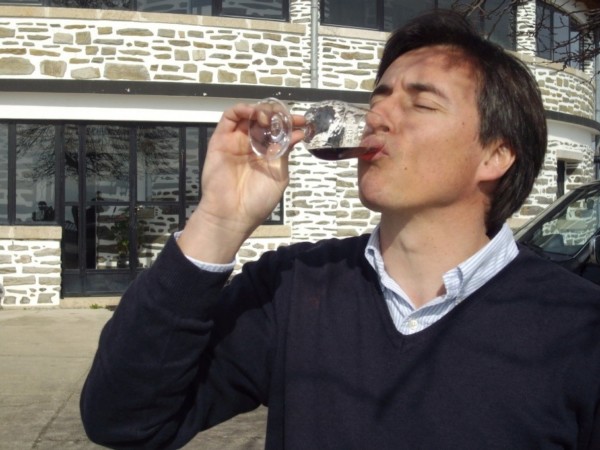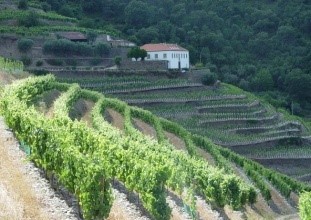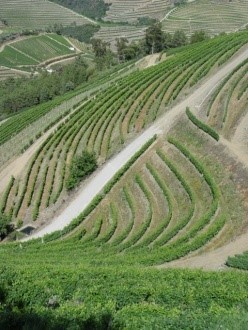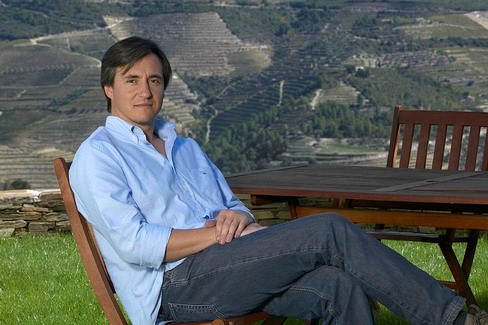FTLOP introduces Douro winemaker Jorge Moreira, of Real Companhia Velha, Poeira and Quinta de la Rosa.

Early on, after earning his degree at UTAD, Jorge Moreira spent seven years as enologist for Real Companhia Velha and I’ve watched his career blossom ever since. Jorge and I first met in May 2003, nearly a year after he took over the reigns as winemaker at Quinta de la Rosa and two years after he and his wife purchased their own quinta and launched Poeira. Quinta de la Rosa’s wines have dramatically improved since he took over. Today, Jorge is one of the most respected young winemakers in the Douro; although he never seeks out fame or glory, allowing his achievements to do the talking. RCV recently asked Jorge to return to help improve the quality of their wines too. Moreira succeeds in all three ventures as a “terroirist” winemaker, as proven by the esteemed 2005 Poeira and Quinta de la Rosa red wines.
Here is Jorge’s story:
1. How did you break into the Porto and Douro wine trade and at what age?
After my graduation in Enology at the University of Vila Real in 1995, I started to work with my brother-in-law in a company making central heating and wood burning stoves, nothing to do with winemaking. I was very happy making my first money and enjoying my work experience but my father was very disappointed and convinced me to work just for one vintage in a wine company. So I started to work in Real Companhia Velha as a trainee just for two months and I left the company after 7 years (coincidentally, seven years later I have returned to the RCV again).
2. What is your favorite style of Douro wine and also Port to drink at home, and can you name 2 or 3 of the greatest one’s you’ve ever tried?
In Douro, we have such a diversity that it is impossible to choose just one style. I love a glass of sparkling wine at the end of a hot day (Vertice is my favourite). A fresh and intense Douro white for summer meals (for example: Lavradores de Feitoria Sauvignon), or a complex and concentrated white wine for dinner (like Niepoort Redoma Reserva), or even a fresh, full flavored fruity red when I just feel like tasting Douro fruit (e.g., Qta de la Rosa or Qta do Crasto), or when I have enough time to appreciate a complex, deep, full of character red wine, (such as Pintas and Qta do Vale Meão just to name two very different styles). I would also like to mention the great late harvest wines that we have (being Grandjó the best example in my opinion). As far as Ports, normally at home I drink 10 year year old tawny, young LBV or vintage Port with at least fifteen years of bottle age. The best vintage Ports I have consumed were Quinta do Noval Nacional from 1931 and Niepoort’s 1927.
3. Besides wines from your own company, what others do you most enjoy drinking?
To be honest, most of the time I don’t enjoy drinking the wines I make, as there is too much stress. I enjoy drinking wines from all over the world since they are made in a way that shows their character and a sense of place … wines that show terroir. My favorites normally come from France, Portugal or Italy. The types I enjoy most are Burgundy, Chateauneuf-du-Pape, Cornas, Pouilly Fume and Bordeaux. Also, Gruner Veltliner from Wachau, (Austria), Riesling from Germany’s Mosel, Brunello di Montalcino from Tuscany and Barolo from the Piedmont.
4. What brings you the most joy in what you do within the Douro wine trade?
The thing that I enjoy most is to look at a vineyard and imagine a beautiful wine from there and then try to create it.

5. Would you please share one piece of unique trivia or historical information about your company that would be new to FTLOP readers?
I work in three different companies. My own making Poeira which was one of the first vineyard oriented, small production, high quality wines in the Douro. Also, Quinta de la Rosa one of the first Single Quintas to bottle their own wines and Real Companhia Velha that was originally a Port company founded by a King (D. José I in 1756).
6. Which individual has been your greatest mentor and how have they inspired you?
Jerry Luper on the technical side and Dirk Niepoort on the emotional.
7. What is the greatest challenge facing the Douro wine trade today?
Convincing people to taste our wines, to show them how interesting and unique they really are.
8. Can you share one new project or improvement that your company is involved with?
We are working hard in understanding the potential of very old traditional grape varieties in the Douro and learning how to best use them to create different styles of wine. The first result will be a wine made from the Rufete grape (which is the Douro’s version of Pinot Noir).
I live at my Quinta Poeira in the Pinhao valley and the most important aspect of my vineyards is that they are all North facing, this means no direct sun in the afternoon. This allows my grapes to ripen slower, keeping the acids and fresh flavors to create an elegant Douro wine. I make Poeira in my home in traditional stone lagares and the grapes are all foot trodden.

9. What can the industry do to improve the promotion and education of Douro wine and grow market share in the ever evolving beverage marketplace?
I think the best wine producers from the Douro have to work together to promote wine tastings and wine events all over the world, in a methodical and consistent way. Not just having individual or generic tastings, but introducing large groups from the best selection of Douro wines.
10. What non-wine activities do you enjoy?
I enjoy running, skiing, diving, reading, music, traveling and spending as much time with my family as I possibly can (my wife Olga; and I have an eleven year old son Miguel and a 4 year old daughter, Margarida).


Leave A Comment
You must be logged in to post a comment.